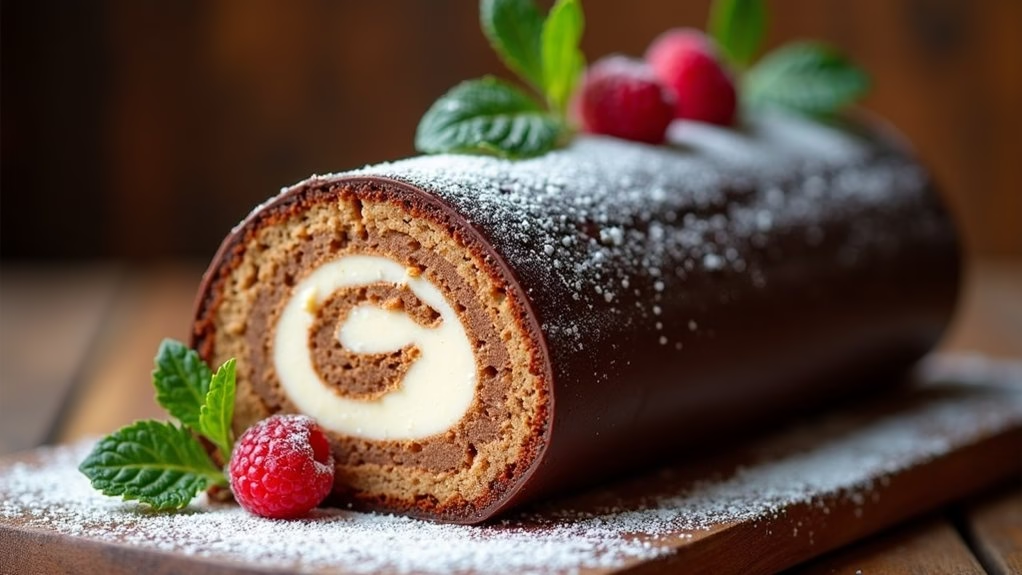As winter’s chill sets in, I find myself yearning for the cozy charm of a rustic cabin filled with the aroma of a hearty Christmas feast. It’s the ideal time to gather around a table with loved ones, enjoying dishes that bring warmth and comfort. Think savory herb-crusted prime rib or sweet maple-glazed roast turkey, each bite tasting like home. Let’s explore recipes that promise to make this holiday season truly unforgettable.
Savory Herb-Crusted Prime Rib
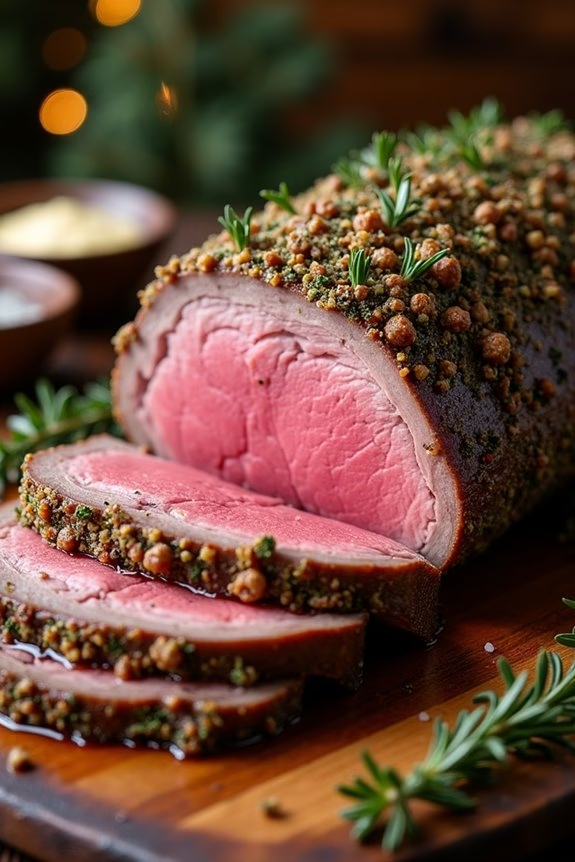
For a truly rustic and hearty Christmas dinner, a Savory Herb-Crusted Prime Rib is a show-stopping centerpiece that will impress your guests. This dish encapsulates the warmth and festivity of the holiday season with its rich aromas and tender, juicy meat. The prime rib, with its marbled texture, is perfect for absorbing the flavors of the herb crust, which includes a fragrant mix of fresh rosemary, thyme, and garlic. When cooked to perfection, the crust forms a delicious, savory layer that complements the succulent beef underneath.
This recipe serves 4-6 people, making it ideal for a family gathering or an intimate holiday celebration. The combination of herbs and spices enhances the natural taste of the beef, while a slow roasting process guarantees even cooking and maximum flavor. Paired with classic sides like roasted potatoes or seasonal vegetables, this dish is sure to bring comfort and joy to your Christmas table.
Ingredients:
- 1 (4-5 pound) bone-in prime rib roast
- 4 cloves garlic, minced
- 1/4 cup fresh rosemary, chopped
- 1/4 cup fresh thyme, chopped
- 1 tablespoon coarse sea salt
- 1 tablespoon freshly ground black pepper
- 2 tablespoons olive oil
- 1 tablespoon Dijon mustard
Cooking Instructions:
- Prepare the Prime Rib: Remove the prime rib from the refrigerator at least 1 hour before cooking to allow it to come to room temperature. This guarantees even cooking throughout the roast.
- Preheat the Oven: Set your oven to 450°F (232°C). Preheating the oven is vital for achieving a good sear on the meat.
- Make the Herb Crust: In a small bowl, combine the minced garlic, chopped rosemary, thyme, sea salt, black pepper, olive oil, and Dijon mustard. Mix until you have a thick paste.
- Apply the Herb Crust: Pat the prime rib dry with paper towels. Rub the herb mixture generously over the entire surface of the meat, guaranteeing it’s evenly coated.
- Roast the Prime Rib: Place the seasoned prime rib on a roasting rack in a shallow pan, bone side down. Roasting on a rack allows hot air to circulate around the meat, promoting even cooking. Insert a meat thermometer into the thickest part of the roast, avoiding the bone.
- Initial High-Temperature Roast: Roast the prime rib at 450°F (232°C) for 15 minutes. This initial high heat will sear the outside, locking in juices.
- Lower the Temperature: Reduce the oven temperature to 325°F (163°C) and continue roasting. For medium-rare, cook until the internal temperature reaches 130°F (54°C), which should take about 1.5 to 2 hours depending on the size of the roast.
- Rest the Meat: Once the desired temperature is reached, remove the roast from the oven, cover it loosely with aluminum foil, and let it rest for at least 20 minutes. Resting allows the juices to redistribute throughout the meat, guaranteeing each slice is juicy and flavorful.
- Carve and Serve: Carefully carve the prime rib against the grain into thick slices and serve with your choice of sides.
Extra Tips:
For the best results, use a meat thermometer to avoid overcooking the prime rib. Remember that the internal temperature will continue to rise slightly as the meat rests. If you prefer your meat cooked to a different degree, adjust the final internal temperature accordingly (e.g., 145°F for medium).
Additionally, for a more intense flavor, prepare the herb crust mixture a day in advance and let the prime rib marinate overnight in the refrigerator. Just be sure to bring it back to room temperature before roasting.
Maple-Glazed Roast Turkey
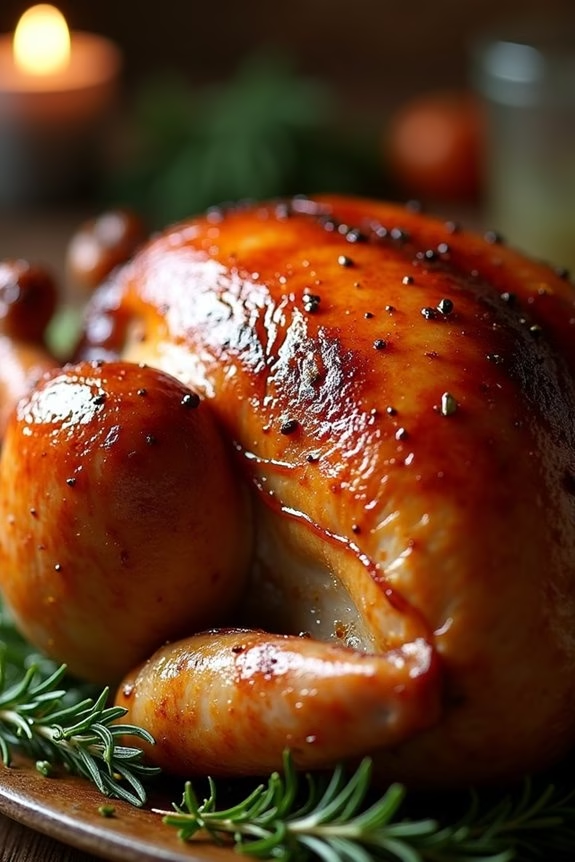
The centerpiece of a rustic Christmas dinner, the Maple-Glazed Roast Turkey, combines the savory flavors of a perfectly roasted bird with the sweet, caramelized richness of maple syrup. This dish isn’t only visually stunning but also a delightful blend of flavors that epitomizes festive warmth.
The maple glaze, infused with aromatic herbs and spices, envelops the turkey in a fragrant, sticky coating that enhances its natural juices, guaranteeing a moist and tender result. Whether you’re hosting a large family gathering or a more intimate celebration, this recipe promises to be a showstopper, leaving everyone at the table in awe of your culinary prowess.
Cooking a turkey can often seem intimidating, but this recipe breaks it down into simple steps, making it accessible even to novice home cooks. By starting with a quality turkey and allowing ample time for marinating and roasting, you’ll achieve a dish that’s both flavorful and succulent.
The use of fresh herbs and a hint of citrus in the glaze not only elevates the flavor profile but also complements traditional holiday sides beautifully. Prepare to impress your guests with this quintessential Christmas dish, perfect for serving 4-6 people.
Ingredients:
- 1 whole turkey (10-12 pounds)
- 1/2 cup pure maple syrup
- 1/4 cup unsalted butter, melted
- 2 tablespoons olive oil
- 3 tablespoons fresh thyme leaves
- 3 tablespoons fresh rosemary leaves
- 1 tablespoon Dijon mustard
- 1 teaspoon salt
- 1/2 teaspoon ground black pepper
- 3 cloves garlic, minced
- Zest and juice of 1 orange
- 2 cups chicken broth
Cooking Instructions:
- Prepare the Turkey: Preheat your oven to 325°F (165°C). Remove the turkey from the refrigerator and let it sit at room temperature for about 30 minutes. This helps facilitate even cooking. Pat the turkey dry with paper towels, removing any giblets and neck from the cavity if present.
- Make the Glaze: In a small saucepan, combine the maple syrup, melted butter, olive oil, thyme, rosemary, Dijon mustard, salt, pepper, minced garlic, orange zest, and juice. Heat over medium-low until well combined, stirring occasionally. Remove from heat and set aside.
- Season the Turkey: Place the turkey on a roasting rack set inside a large roasting pan. Brush the turkey generously with the maple glaze, making sure to cover all surfaces. Season the inside of the cavity with a little salt and pepper.
- Roast the Turkey: Pour the chicken broth into the bottom of the roasting pan to create steam and keep the turkey moist. Place the turkey in the preheated oven and roast for approximately 13-15 minutes per pound, basting every 30 minutes with the remaining glaze. Rotate the pan halfway through cooking for even browning.
- Check for Doneness: After about 2.5 to 3 hours (depending on the size of your turkey), check the internal temperature with a meat thermometer. The turkey is done when it reaches 165°F (74°C) in the thickest part of the breast and thigh.
- Rest and Carve: Remove the turkey from the oven and let it rest for 20-30 minutes before carving. This allows the juices to redistribute, guaranteeing a moist and flavorful turkey. Carve and serve with your favorite sides.
Extra Tips:
For a beautifully golden-brown turkey, make sure your oven is clean and free of excess grease that can cause smoke. If the turkey begins to brown too quickly, loosely tent it with aluminum foil. This will prevent the skin from burning while allowing the meat to cook through.
Honey-Balsamic Glazed Ham
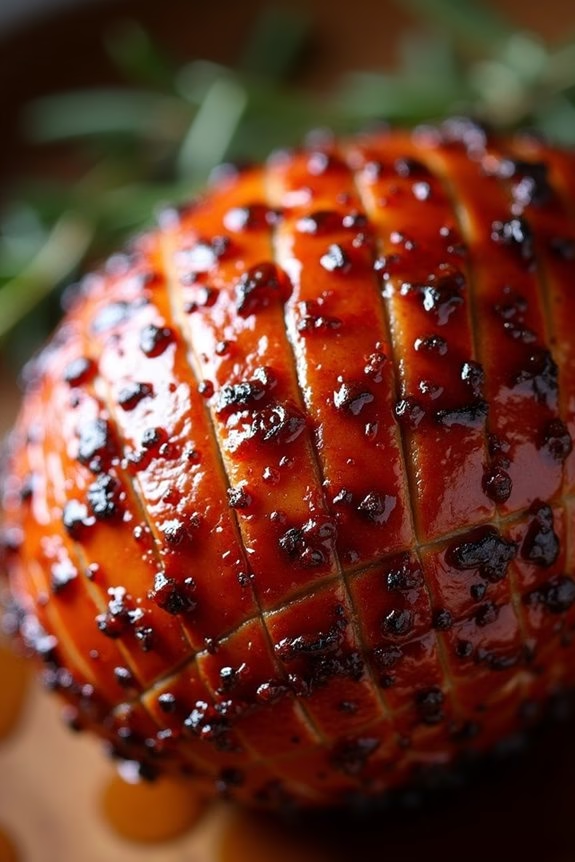
Honey-Balsamic Glazed Ham is a delightful centerpiece for your rustic Christmas dinner. This dish combines the sweetness of honey with the tangy depth of balsamic vinegar, creating a luscious glaze that enhances the natural flavors of the ham. The end result is a perfectly roasted ham with a caramelized crust that’s both sweet and savory, making it an irresistible addition to your holiday table.
Whether you’re hosting a family gathering or an intimate dinner, this recipe is bound to impress your guests and leave them craving for more.
Preparing this dish is a straightforward process that involves a few simple steps, but the outcome is nothing short of spectacular. The key to achieving the perfect Honey-Balsamic Glazed Ham lies in the quality of the ingredients and the patience to let the flavors meld together as the ham roasts.
As the glaze seeps into the meat, it keeps the ham moist and infuses it with a delightful aroma. With minimal effort, you can create a memorable festive meal that embodies the warmth and joy of the holiday season.
Ingredients (for 4-6 servings):
- 1 bone-in ham, approximately 4-6 pounds
- 1 cup honey
- 1/2 cup balsamic vinegar
- 2 tablespoons Dijon mustard
- 1 teaspoon ground black pepper
- 2 teaspoons fresh rosemary, chopped
- 4 cloves garlic, minced
- 1/2 cup brown sugar
Cooking Instructions:
- Preheat the Oven: Preheat your oven to 325°F (165°C). This low temperature guarantees that the ham cooks evenly without drying out.
- Prepare the Glaze: In a medium saucepan, combine the honey, balsamic vinegar, Dijon mustard, black pepper, rosemary, garlic, and brown sugar. Heat the mixture over medium heat, stirring frequently until the sugar dissolves and the glaze is smooth. Remove from heat and let it cool slightly.
- Score the Ham: Using a sharp knife, score the surface of the ham in a crisscross pattern, making sure not to cut too deep. This scoring allows the glaze to penetrate the meat more effectively.
- Apply the Glaze: Place the ham in a roasting pan. Generously brush the glaze over the entire surface of the ham, ensuring it gets into the scored lines.
- Roast the Ham: Cover the ham loosely with aluminum foil and place it in the preheated oven. Roast the ham for about 1.5 to 2 hours, basting it with the remaining glaze every 30 minutes to keep it moist and flavorful.
- Caramelize the Glaze: Remove the foil during the last 20 minutes of cooking to allow the glaze to caramelize and form a beautiful crust.
- Rest and Serve: Once the ham reaches an internal temperature of 140°F (60°C), remove it from the oven and let it rest for 10-15 minutes before carving. This resting period helps the juices redistribute, resulting in a more succulent ham.
Extra Tips:
For best results, choose a high-quality ham to guarantee tenderness and flavor. If you prefer a less sweet glaze, you can reduce the amount of honey or brown sugar.
Additionally, you can prepare the glaze a day in advance to allow the flavors to meld together, enhancing the taste of the final dish. When basting, be generous with the glaze to achieve a rich, sticky coating.
Finally, pairing this dish with seasonal sides like roasted vegetables or mashed potatoes will complete your rustic Christmas feast beautifully.
Rustic Beef Bourguignon
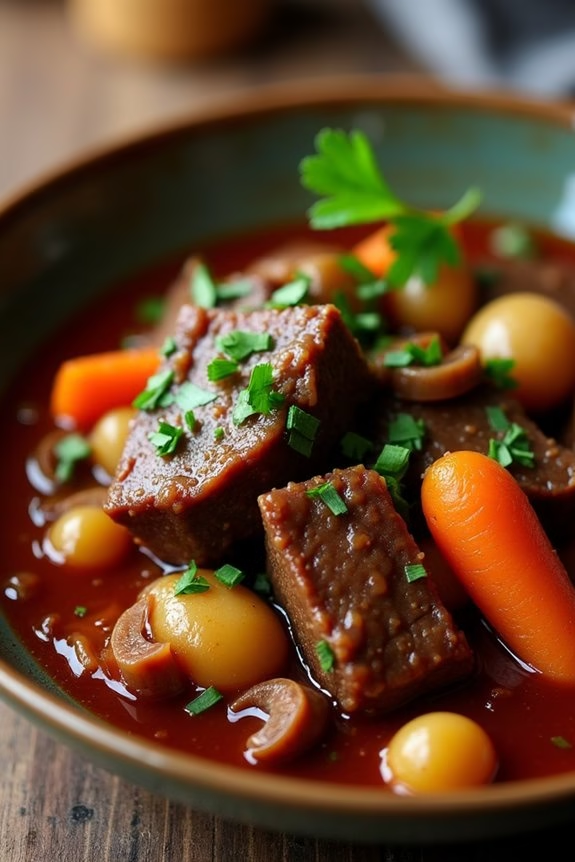
Rustic Beef Bourguignon is a hearty and classic French dish that’s perfect for a cozy Christmas dinner. This traditional recipe brings together tender beef, rich red wine, and an array of vegetables and seasonings to create a deeply flavorful stew. The slow-cooked nature allows the flavors to meld beautifully, resulting in a comforting and satisfying meal that transports you to the rustic countryside of France.
Ideal for the holiday season, this dish not only warms the soul but also impresses guests with its rich taste and beautiful presentation.
For a serving size of 4-6 people, this recipe takes some time but is well worth the effort. The key to a successful Beef Bourguignon is patience and quality ingredients. By carefully choosing your beef and wine, and allowing the dish to simmer slowly, you guarantee that the beef becomes melt-in-your-mouth tender and the sauce achieves a depth of flavor that’s simply irresistible.
Pair it with a crusty loaf of bread or creamy mashed potatoes for a complete holiday feast.
Ingredients:
- 2 lbs beef chuck, cut into 2-inch cubes
- Salt and freshly ground black pepper
- 2 tablespoons olive oil
- 4 ounces bacon, diced
- 1 large onion, sliced
- 2 carrots, sliced
- 3 cloves garlic, minced
- 2 tablespoons flour
- 3 cups red wine (preferably Burgundy or Pinot Noir)
- 2 cups beef broth
- 1 tablespoon tomato paste
- 1 bouquet garni (parsley, thyme, and bay leaf tied together)
- 18-24 pearl onions
- 1 pound mushrooms, quartered
- 2 tablespoons unsalted butter
- Fresh parsley, chopped (for garnish)
Cooking Instructions:
- Prepare the Beef: Season the beef cubes with salt and pepper. In a large Dutch oven, heat olive oil over medium-high heat. Sear the beef in batches until browned on all sides. Remove the beef and set aside.
- Cook the Bacon and Vegetables: In the same pot, add the diced bacon and cook until crispy. Add the sliced onion and carrots, cooking until the onion is translucent. Stir in the minced garlic and cook for another minute.
- Thicken the Base: Sprinkle the flour over the vegetables and stir to coat. Cook for two minutes to remove the flour taste, then return the beef to the pot.
- Add Liquid Ingredients: Pour in the red wine and beef broth, stirring to combine. Add the tomato paste and bouquet garni. Bring the mixture to a simmer, cover, and reduce the heat to low.
- Simmer the Stew: Allow the stew to cook gently for about 2-3 hours, or until the beef is tender. Check occasionally, stirring and skimming off any foam that surfaces.
- Prepare the Garnish Vegetables: While the stew is simmering, in a separate pan, melt the butter. Add the pearl onions and mushrooms, sauté over medium heat until browned and tender. Add these to the stew for the last 30 minutes of cooking.
- Finalize and Serve: Remove the bouquet garni before serving. Taste and adjust seasoning with salt and pepper as needed. Serve hot, garnished with fresh parsley.
Extra Tips:
For the best results, use a quality red wine that you’d enjoy drinking on its own. This greatly enhances the flavor of the dish.
If cooking for a crowd, the stew can be prepared a day in advance and gently reheated before serving, as it often tastes even better the next day.
For added depth, consider adding a splash of cognac just before serving. Remember, the key to a perfect Beef Bourguignon is low and slow cooking, allowing the flavors to develop fully.
Cranberry-Orange Stuffed Pork Loin
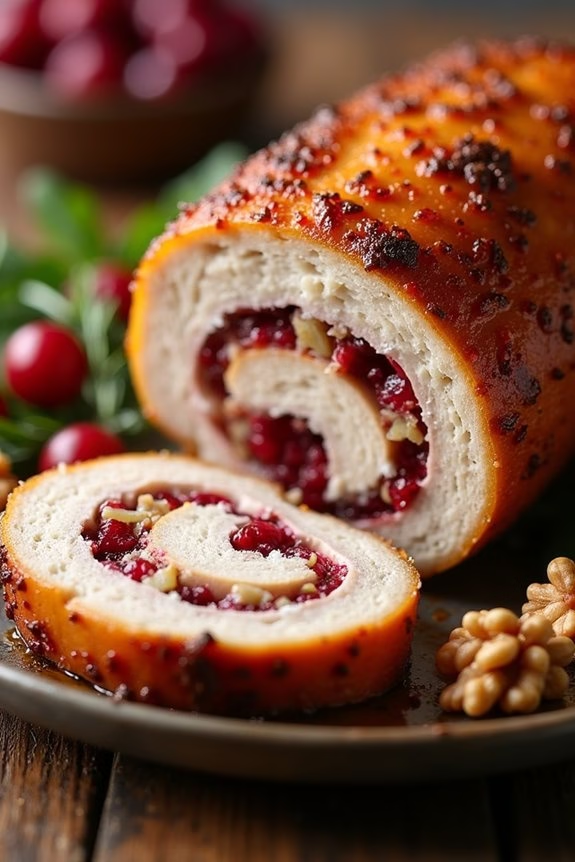
Indulge in the flavors of a rustic Christmas dinner with this delectable Cranberry-Orange Stuffed Pork Loin. This dish combines the sweetness of cranberries and the zesty brightness of oranges, creating a perfect balance of flavors that will delight your taste buds. The pork loin, tender and juicy, serves as the perfect vessel for this fruity stuffing, providing a holiday centerpiece that’s both elegant and comforting. This recipe is sure to impress your family and guests, making your Christmas dinner a memorable affair.
The preparation of this dish involves a beautiful symphony of flavors and aromas. Cranberries add a touch of tartness, while the orange zest and juice infuse the stuffing with a revitalizing citrusy note. The pork loin, carefully butterflied and rolled, showcases the stuffing in a visually appealing manner. Roasting it to perfection locks in the flavors, guaranteeing that every bite is a burst of holiday cheer.
Whether you’re an experienced cook or a novice in the kitchen, this Cranberry-Orange Stuffed Pork Loin is a delightful recipe that will bring warmth and joy to your Christmas table.
Ingredients for 4-6 servings:
- 2-pound pork loin
- 1 cup fresh cranberries
- 1/4 cup orange juice
- Zest of 1 orange
- 1/4 cup chopped walnuts
- 1/4 cup breadcrumbs
- 1 tablespoon honey
- 1 teaspoon ground cinnamon
- 1/2 teaspoon ground nutmeg
- Salt and pepper to taste
- 2 tablespoons olive oil
- Kitchen twine
Cooking Instructions:
- Preheat the Oven: Begin by preheating your oven to 375°F (190°C). This guarantees that the pork loin cooks evenly and the stuffing is heated through.
- Prepare the Stuffing: In a medium saucepan, combine the cranberries, orange juice, orange zest, honey, cinnamon, nutmeg, and a pinch of salt. Cook over medium heat until the cranberries start to burst and the mixture thickens, about 5-7 minutes. Remove from heat, stir in the chopped walnuts and breadcrumbs, and set aside to cool slightly.
- Butterfly the Pork Loin: Using a sharp knife, carefully butterfly the pork loin by slicing it horizontally, being careful not to cut all the way through. Open the pork loin like a book and season both sides with salt and pepper.
- Stuff and Roll the Pork: Spread the cranberry-orange mixture evenly over the inside of the butterflied pork loin. Roll up the pork tightly, securing it with kitchen twine at 1-inch intervals to hold the stuffing in place.
- Sear the Pork: In a large ovenproof skillet, heat the olive oil over medium-high heat. Add the rolled pork loin and sear on all sides until golden brown, about 2-3 minutes per side.
- Roast the Pork: Transfer the skillet to the preheated oven and roast for 25-30 minutes, or until the internal temperature reaches 145°F (63°C). This guarantees the pork is cooked through but still juicy.
- Rest and Serve: Remove the pork from the oven and let it rest for about 10 minutes before slicing. Resting allows the juices to redistribute throughout the meat, guaranteeing each slice is moist and flavorful.
Extra Tips:
When preparing this dish, make sure to not overstuff the pork loin, as this might cause the stuffing to spill out during cooking. You can prepare the cranberry-orange mixture a day in advance to save time on the day of your dinner.
If you prefer a sweeter stuffing, consider adding a bit more honey to the mixture. To make slicing easier, use a sharp knife and cut the pork loin into 1-inch thick slices. Pair this dish with your favorite seasonal side dishes, such as roasted vegetables or a fresh green salad, to complete your festive meal.
Wild Mushroom Risotto
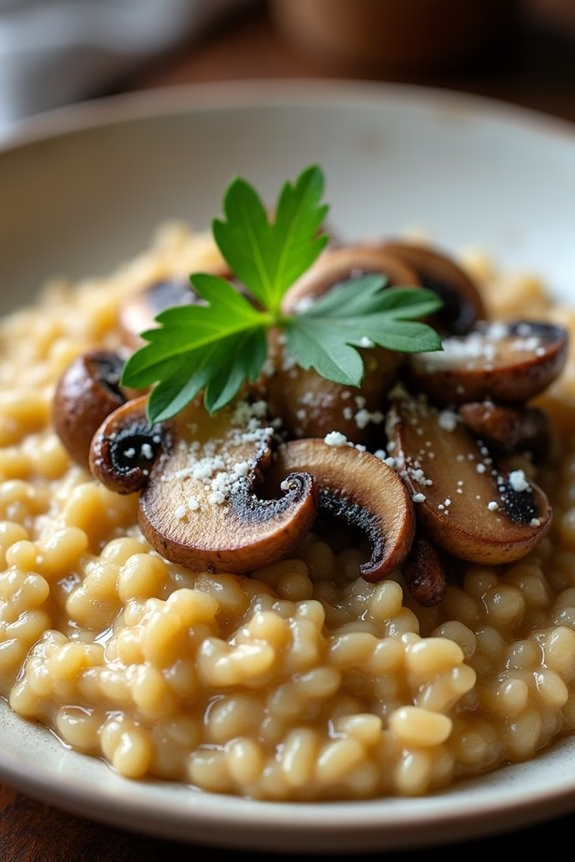
Indulge in the rich and earthy flavors of Wild Mushroom Risotto, a dish perfect for a rustic Christmas dinner. This creamy risotto is infused with the robust essence of a variety of wild mushrooms, offering a comforting and luxurious experience with each bite. The combination of Arborio rice with a blend of wild mushrooms, garlic, shallots, and a hint of white wine creates a dish that’s both elegant and satisfying. This recipe is designed to serve 4-6 people, making it an ideal choice for a festive gathering.
The key to a perfect Wild Mushroom Risotto lies in using high-quality ingredients and applying a patient cooking technique. The slow cooking process allows the rice to gradually absorb the rich flavors of the broth and mushrooms, resulting in a dish that’s creamy yet retains a slight bite. Whether you’re a seasoned chef or a home cook, this recipe is accessible and sure to impress your guests with its depth of flavor and exquisite texture.
Ingredients for 4-6 servings:
- 1 1/2 cups Arborio rice
- 6 cups chicken or vegetable broth
- 1 cup dry white wine
- 1 pound wild mushrooms (such as porcini, shiitake, and chanterelles), cleaned and sliced
- 2 tablespoons olive oil
- 1 tablespoon unsalted butter
- 2 shallots, finely chopped
- 3 cloves garlic, minced
- 1/2 cup grated Parmesan cheese
- Salt and freshly ground black pepper, to taste
- 2 tablespoons fresh parsley, chopped (optional)
- Additional Parmesan for serving (optional)
Cooking Instructions:
- Prepare the broth: In a medium saucepan, heat the chicken or vegetable broth over low heat. Keep it warm throughout the cooking process to guarantee even absorption.
- Cook the mushrooms: In a large skillet, heat the olive oil over medium heat. Add the sliced wild mushrooms and sauté for about 5-7 minutes until they release their moisture and become golden brown. Remove from the skillet and set aside.
- Sauté aromatics: In the same skillet, add the butter. Once melted, add the finely chopped shallots and minced garlic. Sauté for 2-3 minutes until the shallots are translucent and the garlic is fragrant.
- Toast the rice: Add the Arborio rice to the skillet with the shallots and garlic. Stir continuously for about 2 minutes, ensuring the rice is well-coated and lightly toasted.
- Deglaze with wine: Pour in the white wine and stir until it’s mostly absorbed by the rice. This step adds a depth of flavor to the risotto.
- Add broth gradually: Begin adding the warm broth one ladle at a time, stirring frequently. Allow each addition of broth to be absorbed before adding the next. This process should take about 18-20 minutes, resulting in creamy rice with a slight al dente texture.
- Incorporate mushrooms: Once the rice is cooked to your desired consistency, stir in the sautéed mushrooms. Mix well to distribute the mushrooms evenly throughout the risotto.
- Finish with cheese: Remove the risotto from the heat and stir in the grated Parmesan cheese. Season with salt and freshly ground black pepper to taste. If desired, garnish with chopped fresh parsley and additional Parmesan before serving.
Extra Tips:
To enhance the flavor of your Wild Mushroom Risotto, consider using a mix of wild mushrooms for a variety of textures and tastes. If fresh wild mushrooms aren’t available, dried mushrooms can be rehydrated and used as a substitute.
When adding the broth, be patient and stir constantly to achieve the best creamy consistency. Avoid rushing the process as it allows the flavors to meld beautifully, guaranteeing a deliciously rich risotto. Finally, serve the risotto immediately after cooking for the best texture and flavor.
Roasted Root Vegetable Medley
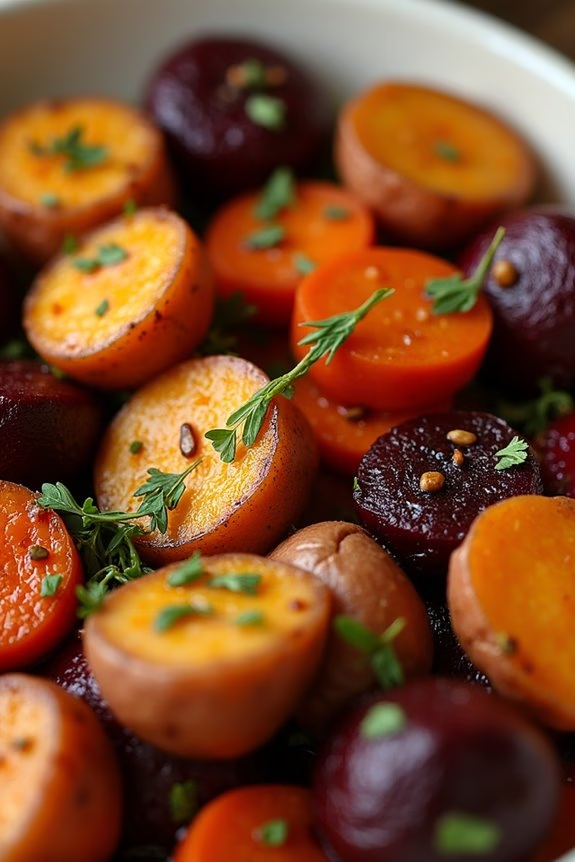
Celebrate the warmth and comfort of the holiday season with a delightful Roasted Root Vegetable Medley. This dish brings together the earthy flavors of root vegetables, perfectly roasted to highlight their natural sweetness and hearty texture. It’s an ideal side dish for your Christmas feast, offering a colorful and nutritious complement to the main course.
Whether you’re serving a traditional roast or a plant-based centerpiece, this medley is versatile enough to pair beautifully with any holiday spread.
The key to elevating this dish lies in the selection and preparation of the vegetables. Choose a variety of root vegetables to create a visually appealing and deliciously diverse dish. Carrots, parsnips, sweet potatoes, and beets are excellent choices for their contrasting colors and complementary flavors.
To enhance the natural sweetness of the vegetables, a drizzle of honey and a sprinkle of fresh herbs like rosemary and thyme are added before roasting. The result is a golden, caramelized medley with a tantalizing aroma that will make your Christmas dinner truly memorable.
Ingredients (Serves 4-6):
- 4 large carrots
- 3 parsnips
- 2 medium sweet potatoes
- 3 medium-sized beets
- 2 tablespoons olive oil
- 1 tablespoon honey
- 1 teaspoon salt
- 1/2 teaspoon black pepper
- 2 teaspoons fresh rosemary, chopped
- 2 teaspoons fresh thyme, chopped
Cooking Instructions:
- Preheat the Oven: Start by preheating your oven to 400°F (200°C). This guarantees that the vegetables will roast evenly and develop a nice caramelization.
- Prepare the Vegetables: Peel the carrots, parsnips, sweet potatoes, and beets. Cut them into roughly equal-sized pieces, about 1-inch thick. This will assure they cook evenly.
- Mix the Vegetables: In a large mixing bowl, combine the chopped vegetables. Add the olive oil, honey, salt, pepper, rosemary, and thyme. Toss everything until the vegetables are well coated.
- Arrange on a Baking Sheet: Spread the seasoned vegetables in a single layer on a large baking sheet. Make sure there’s enough space between the pieces to allow for proper roasting.
- Roast: Place the baking sheet in the preheated oven and roast for about 35-40 minutes. Halfway through, use a spatula to gently turn the vegetables to guarantee even browning.
- Check for Doneness: The vegetables are done when they’re tender and golden brown. You can test a piece with a fork; it should slide in easily.
- Serve: Once roasted, remove from the oven and transfer to a serving platter. Serve warm as part of your Christmas dinner spread.
Extra Tips:
For an extra depth of flavor, try adding a splash of balsamic vinegar to the vegetable mixture before roasting. If you prefer a more savory dish, omit the honey and add a dash of smoked paprika or ground cumin.
Additionally, if you’re preparing this dish in advance, you can roast the vegetables a day ahead and reheat them in the oven before serving. This will save time on the day of your Christmas feast, allowing you to focus on other dishes. Enjoy this delightful addition to your holiday table!
Garlic and Herb Mashed Potatoes

Nothing says “comfort” quite like a bowl of creamy, fluffy mashed potatoes, especially when infused with the aromatic flavors of garlic and fresh herbs. This recipe for Garlic and Herb Mashed Potatoes is a perfect addition to your rustic Christmas dinner, offering a deliciously savory side dish that complements roasted meats and vegetables beautifully.
The combination of garlic’s robust flavor with the subtle earthiness of herbs transforms ordinary mashed potatoes into a festive feast.
For this recipe, we’ll be using a blend of fresh rosemary, thyme, and parsley, alongside roasted garlic to enhance the flavor profile of the potatoes. The key to achieving the perfect texture is using a starchy potato variety, such as Russets or Yukon Golds, which mash smoothly and absorb the flavors well.
Serve this dish to 4-6 people, and watch as it becomes a family favorite that you’ll want to make every holiday season.
Ingredients:
- 3 pounds Russet or Yukon Gold potatoes
- 1/2 cup unsalted butter
- 1 cup heavy cream
- 6 cloves garlic
- 1 tablespoon fresh rosemary, finely chopped
- 1 tablespoon fresh thyme, finely chopped
- 1/4 cup fresh parsley, finely chopped
- Salt and pepper to taste
Instructions:
- Prepare the Garlic: Preheat your oven to 400°F (200°C). Peel and trim the ends of the garlic cloves, then wrap them in aluminum foil with a drizzle of olive oil. Roast in the oven for about 20-25 minutes until the garlic is soft and fragrant. Once done, let it cool, then mash it into a paste.
- Boil the Potatoes: Peel and cut the potatoes into evenly sized chunks. Place them in a large pot, cover with cold water, and add a generous pinch of salt. Bring to a boil over medium-high heat, then reduce the heat to a simmer. Cook for 15-20 minutes, or until the potatoes are fork-tender.
- Heat the Cream and Butter: In a small saucepan over low heat, combine the butter and heavy cream. Warm them up until the butter is melted, stirring occasionally.
- Mash the Potatoes: Drain the potatoes well and return them to the pot. Use a potato masher or a ricer for smoother texture. Add the roasted garlic paste, warm butter and cream mixture, and the chopped herbs to the potatoes. Mix until everything is well incorporated and the potatoes are creamy and smooth.
- Season and Serve: Taste and season the mashed potatoes with salt and pepper as needed. Transfer to a serving dish, garnish with additional fresh herbs if desired, and serve warm.
Extra Tips:
For the best texture, avoid over-mixing the potatoes as this can lead to a gummy consistency. If you prefer a chunkier mash, use a masher rather than a ricer.
Feel free to adjust the amount of garlic and herbs to suit your taste preferences. If you find your mashed potatoes are too thick, you can add a bit more cream or even some of the reserved potato cooking water to reach the desired consistency.
Enjoy these potatoes fresh, but they can also be made a day ahead and reheated gently over low heat with a splash of cream to revive their texture.
Caramelized Brussels Sprouts With Bacon
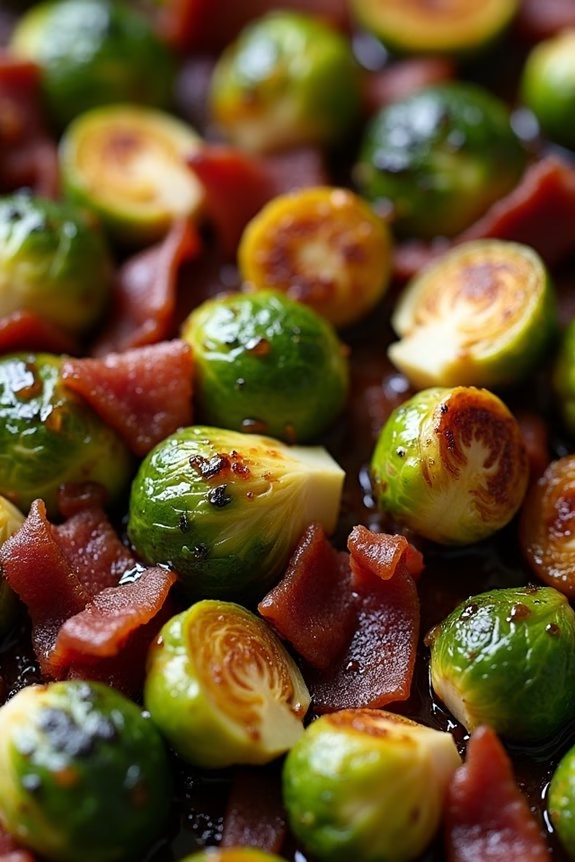
Caramelized Brussels Sprouts With Bacon is a delightful side that perfectly complements any holiday feast, particularly a rustic Christmas dinner. This dish combines the earthy, slightly bitter flavor of Brussels sprouts with the savory, smoky goodness of bacon and the sweetness from caramelization, creating a harmonious blend that’s both comforting and sophisticated.
The crispy bacon bits add a delightful crunch, while the caramelized sprouts provide a tender, sweet contrast. It’s a dish that even those hesitant about Brussels sprouts will find hard to resist.
Perfect for serving 4-6 people, this recipe isn’t only flavorful but also simple to prepare, making it an ideal choice for a festive gathering. The combination of ingredients creates a rich, satisfying dish that can be prepared in under an hour, allowing you to focus on other elements of your Christmas meal.
Whether you’re preparing a traditional holiday spread or looking to add a new twist to your menu, Caramelized Brussels Sprouts With Bacon is sure to be a crowd-pleaser.
Ingredients:
- 1½ pounds Brussels sprouts, trimmed and halved
- 6 slices thick-cut bacon, diced
- 2 tablespoons olive oil
- 2 tablespoons balsamic vinegar
- 1 tablespoon maple syrup
- Salt and freshly ground black pepper to taste
Cooking Instructions:
- Prepare the Brussels Sprouts: Begin by trimming the ends of the Brussels sprouts and removing any yellow or damaged outer leaves. Cut each sprout in half to guarantee even cooking.
- Cook the Bacon: In a large skillet over medium heat, add the diced bacon. Cook until the bacon becomes crispy and golden brown, stirring occasionally to guarantee even cooking. Once cooked, use a slotted spoon to remove the bacon from the skillet and drain on a paper towel-lined plate. Leave the bacon grease in the skillet.
- Sauté the Brussels Sprouts: Add 2 tablespoons of olive oil to the skillet with the bacon grease. Increase the heat to medium-high and add the Brussels sprouts, cut side down. Cook for about 5-7 minutes until the cut sides are caramelized and browned. Stir occasionally to avoid burning.
- Caramelize: Once the Brussels sprouts are nicely browned, reduce the heat to medium and add the balsamic vinegar and maple syrup. Stir well to coat the sprouts evenly. Cook for an additional 3-5 minutes until the Brussels sprouts are tender and the sauce has thickened slightly.
- Combine and Season: Return the cooked bacon to the skillet and mix with the Brussels sprouts. Season with salt and freshly ground black pepper to taste. Stir to combine all flavors thoroughly.
- Serve: Transfer the caramelized Brussels sprouts and bacon to a serving dish. Serve hot as a delicious side dish to your holiday meal.
Extra Tips: For best results, choose fresh and firm Brussels sprouts, as they’ll caramelize better than older, softer ones. If you prefer a sweeter finish, you can add an extra tablespoon of maple syrup.
For a bit of heat, sprinkle some crushed red pepper flakes during the final seasoning step. Additionally, this dish can be prepared ahead of time and reheated in the oven at 350°F for about 10 minutes before serving, making it a convenient option for busy holiday cooking.
Buttery Skillet Cornbread

As the holiday season approaches, there’s nothing quite like the comforting warmth of a rustic Christmas dinner to bring family and friends together. Among the many delectable dishes that can grace your festive table, Buttery Skillet Cornbread stands out as a timeless classic. With its golden crust and moist, tender crumb, this cornbread is the perfect accompaniment to hearty main courses or can be savored on its own with a pat of butter.
Made with simple, wholesome ingredients, this recipe is both easy to prepare and a delightful addition to your holiday feast. The key to achieving the perfect Buttery Skillet Cornbread lies in the use of a cast-iron skillet, which guarantees even heat distribution and a beautifully crisp exterior.
Whether you’re serving this cornbread alongside a succulent roast or as part of a more casual holiday spread, it’s sure to be a hit with everyone gathered around your table. This recipe is designed to serve 4-6 people, making it ideal for family gatherings or small holiday parties.
Ingredients (Serves 4-6):
- 1 cup of yellow cornmeal
- 1 cup of all-purpose flour
- 1/4 cup of granulated sugar
- 1 tablespoon of baking powder
- 1/2 teaspoon of baking soda
- 1/2 teaspoon of salt
- 1 cup of buttermilk
- 2 large eggs
- 1/4 cup of melted butter
- 2 tablespoons of vegetable oil
Cooking Instructions:
- Preheat the Oven: Begin by preheating your oven to 425°F (220°C). Place your cast-iron skillet in the oven while it heats up. This will help create a crisp, golden crust on your cornbread.
- Mix Dry Ingredients: In a large mixing bowl, combine the cornmeal, flour, sugar, baking powder, baking soda, and salt. Stir well to confirm all ingredients are evenly distributed.
- Prepare Wet Ingredients: In a separate bowl, whisk together the buttermilk and eggs until they’re well combined. Gradually incorporate the melted butter into this mixture, whisking continuously to ensure a smooth blend.
- Combine Mixtures: Pour the wet ingredients into the bowl of dry ingredients. Stir the mixture gently until just combined. Be careful not to overmix, as this can result in a dense cornbread.
- Heat the Skillet: Carefully remove the preheated skillet from the oven and add the vegetable oil, swirling it around to coat the bottom and sides of the skillet evenly.
- Bake the Cornbread: Pour the batter into the hot, oiled skillet, smoothing the top with a spatula. Return the skillet to the oven and bake for 20-25 minutes, or until the cornbread is golden brown and a toothpick inserted into the center comes out clean.
- Cool and Serve: Allow the cornbread to cool in the skillet for a few minutes before slicing and serving. Enjoy it warm for the best flavor and texture.
Extra Tips:
For an added burst of flavor, consider incorporating some optional ingredients such as chopped jalapeños, shredded cheddar cheese, or a handful of sweet corn kernels into the batter.
Additionally, using room temperature eggs and buttermilk can help the batter blend more smoothly. If you don’t have buttermilk on hand, you can make a quick substitute by mixing one cup of milk with a tablespoon of lemon juice or vinegar and let it sit for a few minutes before using.
Finally, if your cast-iron skillet is well-seasoned, it will contribute to a perfect non-stick surface, allowing your cornbread to slide out effortlessly.
Cranberry-Walnut Holiday Salad
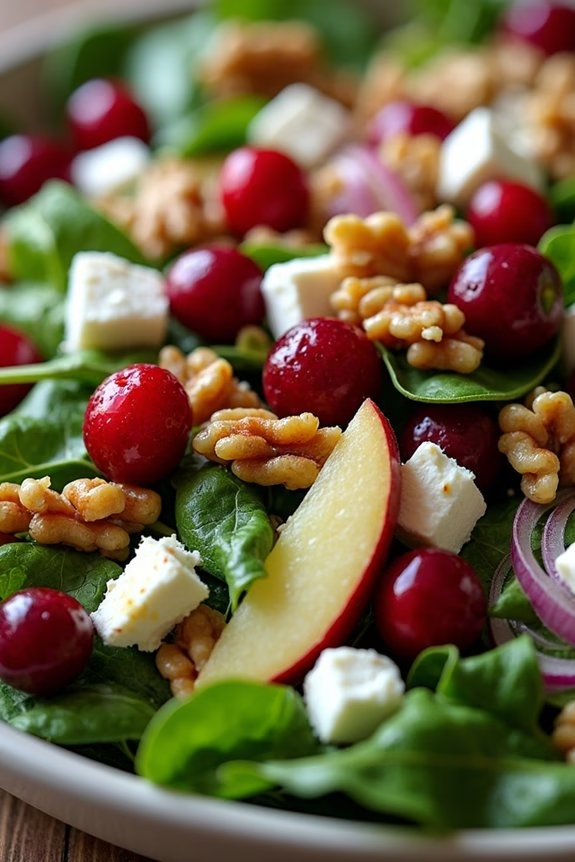
Celebrate the festive season with a delightful Cranberry-Walnut Holiday Salad that captures the essence of a rustic Christmas dinner. This salad combines the tartness of cranberries with the earthy crunch of walnuts, creating a perfect balance of flavors and textures. The addition of fresh greens and a zesty homemade dressing elevates this dish into a revitalizing starter or side that complements any holiday meal.
With its vibrant colors and enticing aroma, this salad is sure to become a cherished part of your holiday traditions. The Cranberry-Walnut Holiday Salad not only embodies the spirit of the season but also offers a nutritious boost amidst the indulgence of Christmas feasting. The crunchy walnuts provide heart-healthy fats, while cranberries are rich in antioxidants.
Tossed together with crisp greens and a tangy dressing, this salad is both wholesome and indulgent. Prepare this dish for a serving size of 4-6 people, guaranteeing there’s plenty to share and enjoy with family and friends.
Ingredients (Serves 4-6):
- 5 cups mixed greens (such as arugula, spinach, and romaine)
- 1 cup fresh or dried cranberries
- 1 cup walnuts, toasted
- 1/2 cup crumbled feta cheese
- 1/4 red onion, thinly sliced
- 1 medium apple, thinly sliced
- 1/4 cup balsamic vinegar
- 1/4 cup olive oil
- 1 tablespoon honey
- Salt and pepper to taste
Instructions:
- Prepare the Greens: Start by washing and drying the mixed greens thoroughly. Use a salad spinner to guarantee they’re crisp and free of excess water. Place them in a large salad bowl.
- Toasting the Walnuts: In a dry skillet over medium heat, toast the walnuts for about 3-5 minutes, stirring frequently until they’re golden brown and fragrant. Remove from heat and let them cool.
- Assemble the Salad: Add the cranberries, cooled walnuts, feta cheese, red onion, and apple slices to the bowl of greens. Toss gently to combine all the ingredients evenly.
- Make the Dressing: In a small bowl, whisk together the balsamic vinegar, olive oil, honey, salt, and pepper until well combined. Adjust the seasoning to your taste.
- Dress the Salad: Drizzle the dressing over the salad just before serving. Toss gently to guarantee everything is coated with the dressing.
- Serve: Transfer the salad to a serving platter or individual plates. Enjoy immediately for the best flavor and texture.
Extra Tips:
When preparing the Cranberry-Walnut Holiday Salad, consider adding a touch of citrus zest to the dressing for an extra layer of flavor. If using dried cranberries, you can soak them in warm water for about 5 minutes to plump them up and enhance their juiciness.
Be mindful of the saltiness of the feta cheese when seasoning the dressing, as it can quickly become too salty. For a more robust flavor profile, you can also add a sprinkle of freshly ground black pepper on top before serving.
Spiced Mulled Wine

As the chill of winter sets in, there’s nothing more comforting than gathering around the fireplace with a warm glass of Spiced Mulled Wine. This traditional holiday beverage is a staple at Christmas gatherings, bringing with it a fragrant blend of spices and citrus that fills the room with an inviting aroma.
Perfect for a cozy evening with friends or family, this recipe captures the essence of the season, combining rich red wine with a medley of flavors that warm both the body and soul.
Making Spiced Mulled Wine is a relatively simple process that requires minimal ingredients and effort, yet yields a deeply satisfying result. The key to a successful mulled wine lies in the perfect balance of spices and sweetness.
This recipe is designed for a serving size of 4-6 people, and it’s best enjoyed slowly, allowing the flavors to meld beautifully as it simmers. Whether you’re planning a rustic Christmas dinner or just a quiet night in, this Spiced Mulled Wine will surely enhance the festive spirit.
Ingredients for 4-6 servings:
- 1 bottle (750ml) of red wine (Merlot or Cabernet Sauvignon)
- 1/4 cup brandy
- 1/4 cup honey
- 1 orange, sliced
- 1 lemon, sliced
- 6 whole cloves
- 3 cinnamon sticks
- 2 star anise
- 1/4 teaspoon ground nutmeg
- 1 vanilla pod, split
- Fresh cranberries for garnish (optional)
Cooking Instructions:
1. Prepare the Base:
In a large saucepan or pot, pour the red wine and brandy. Set the heat to low to gently warm the liquids without bringing them to a boil. Boiling can cause the alcohol to evaporate too quickly.
2. Add the Sweetness:
Stir in the honey, making sure it fully dissolves into the wine. The honey not only adds sweetness but also contributes a subtle depth to the flavor profile.
3. Infuse with Citrus:
Add the sliced orange and lemon to the pot, allowing the citrus oils and juices to blend with the wine. This step is essential for the fresh, zesty undertone characteristic of mulled wine.
4. Spice it Up:
Incorporate the cloves, cinnamon sticks, star anise, ground nutmeg, and the vanilla pod into the pot. These spices are what give mulled wine its signature warmth and complexity.
5. Simmer and Meld:
Let the mixture simmer on low heat for 15-20 minutes. Stir occasionally and make sure it doesn’t reach a boil. This slow infusion allows the spices and citrus to release their full flavors.
6. Serve:
Once the wine is adequately infused, strain the mixture to remove the larger spices and citrus slices. Serve the mulled wine warm in mugs or heatproof glasses, garnished with fresh cranberries if desired.
Extra Tips:
For the best results, choose a wine that isn’t too dry but has enough body to complement the spices, like a Merlot or Cabernet Sauvignon.
Adjust the sweetness to your preference by varying the amount of honey or substituting it with brown sugar for a different flavor profile. You can also add a splash more brandy for an extra kick.
If you have leftovers, mulled wine can be stored in the refrigerator and reheated gently, retaining its delicious flavors for a few days.
Rustic Apple Galette
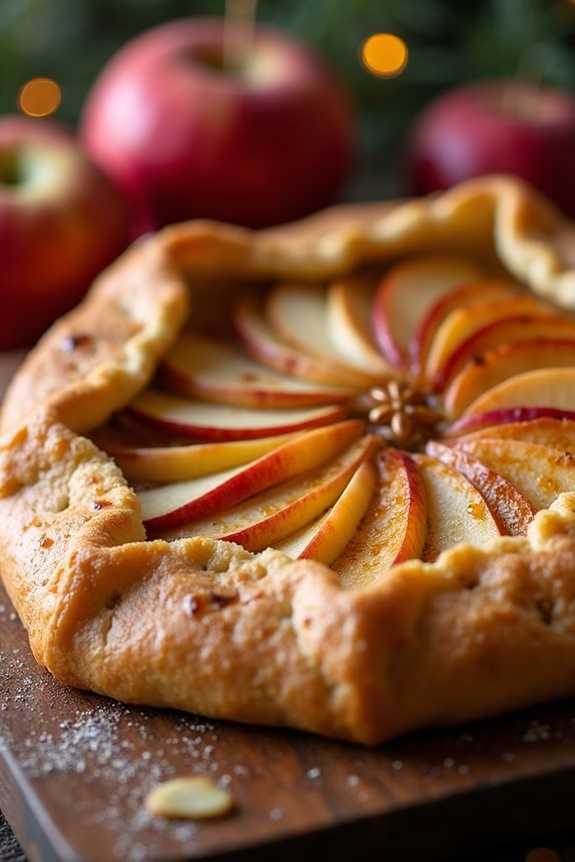
A rustic apple galette is a charming and delicious centerpiece for any Christmas dinner. This French-inspired dessert combines the warm, comforting flavors of spiced apples with a flaky, buttery crust. Unlike a traditional pie, a galette is freeform and forgiving, making it an excellent choice for both novice and seasoned bakers.
The simplicity of the ingredients allows the natural sweetness of the apples to shine through, complemented by a hint of cinnamon and nutmeg. This dessert not only appeals to the eyes with its golden-brown crust and beautifully arranged apple slices but also fills the home with the irresistible aroma of baked apples and spices.
The galette’s rustic nature allows for a relaxed preparation process, making it perfect for the hectic holiday season. With its inviting appearance and delightful taste, this apple galette is sure to be a crowd-pleaser at your Christmas dinner. Best of all, it requires minimal ingredients, so you can focus more on enjoying the festivities and less on complicated recipes.
Serve it warm with a scoop of vanilla ice cream or a dollop of whipped cream for an added touch of indulgence.
Ingredients for 4-6 Servings
- 1 1/2 cups all-purpose flour
- 1/4 cup granulated sugar
- 1/2 teaspoon salt
- 1/2 cup unsalted butter, chilled and cubed
- 1/4 cup ice water
- 4 medium apples, peeled, cored, and sliced
- 1/4 cup brown sugar
- 1 teaspoon ground cinnamon
- 1/4 teaspoon ground nutmeg
- 1 tablespoon lemon juice
- 1 tablespoon cornstarch
- 1 egg, beaten (for egg wash)
- 1 tablespoon coarse sugar (optional)
Cooking Instructions
- Prepare the Dough: In a large bowl, mix the flour, granulated sugar, and salt. Add the chilled cubed butter and use a pastry cutter or your fingers to blend until the mixture resembles coarse crumbs. Gradually add the ice water, one tablespoon at a time, mixing until the dough just comes together. Form the dough into a disk, wrap it in plastic wrap, and refrigerate for at least 1 hour.
- Preheat the Oven: Set your oven to 400°F (200°C) and line a baking sheet with parchment paper.
- Prepare the Apple Filling: In another bowl, combine the sliced apples, brown sugar, cinnamon, nutmeg, lemon juice, and cornstarch. Toss until the apples are evenly coated.
- Roll Out the Dough: On a lightly floured surface, roll out the chilled dough into a 12-inch circle. Transfer the dough to the prepared baking sheet.
- Assemble the Galette: Arrange the apple mixture in the center of the dough, leaving a 2-inch border. Carefully fold the edges of the dough over the apples, pleating as necessary.
- Brush and Sprinkle: Brush the dough edges with the beaten egg and, if desired, sprinkle coarse sugar over the crust for extra crunch and sweetness.
- Bake: Place the galette in the preheated oven and bake for 35-40 minutes, or until the crust is golden brown and the apples are tender.
- Cool and Serve: Allow the galette to cool slightly before slicing. Serve warm with a scoop of vanilla ice cream or whipped cream, if desired.
Extra Tips
For the best results, use a mix of apple varieties to balance sweetness and tartness; Granny Smith and Honeycrisp are excellent choices. Confirm your butter is well-chilled to achieve a flaky crust, and if time permits, chill the assembled galette for 10 minutes before baking to help maintain its shape.
If you find the edges browning too quickly, tent them with foil during the last few minutes of baking. Remember, a galette is meant to be rustic, so embrace any imperfections in its shape—they add to the charm and appeal of this delightful holiday dessert.
Chocolate Hazelnut Yule Log Cake
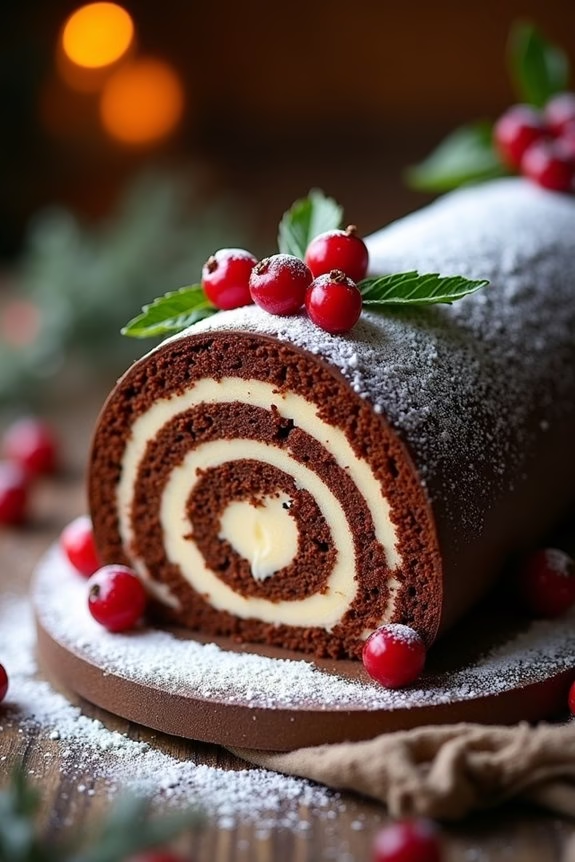
Chocolate Hazelnut Yule Log Cake is a quintessential holiday dessert that brings the warmth and charm of a rustic Christmas dinner to your table. This delightful cake combines the rich flavors of chocolate and hazelnut, wrapped in a beautifully rolled sponge cake that resembles a classic yule log. Perfect for a festive gathering, this cake not only tastes divine but also makes a stunning centerpiece for your holiday spread.
With its decadent filling and elegant presentation, the Chocolate Hazelnut Yule Log Cake is certain to impress your family and friends.
Creating this cake involves crafting a light and fluffy chocolate sponge, which is generously filled with a luscious hazelnut cream. The entire cake is then enveloped in a rich chocolate ganache and adorned with festive decorations. Whether you’re a seasoned baker or trying your hand at yule log for the first time, this recipe is designed to guide you through each step with ease.
Follow along to create a spectacular dessert that embodies the spirit of Christmas, with servings for 4-6 people.
Ingredients:
- 4 large eggs, separated
- 100g granulated sugar
- 1 tsp vanilla extract
- 50g all-purpose flour
- 30g cocoa powder
- 1/2 tsp baking powder
- 1/4 tsp salt
- 200ml heavy cream
- 100g hazelnut spread
- 200g dark chocolate, chopped
- 100ml heavy cream (for ganache)
- Powdered sugar, for dusting
- Fresh berries or mint leaves, for garnish (optional)
Instructions:
- Preheat and Prepare the Baking Sheet: Preheat your oven to 350°F (175°C). Line a 15×10-inch jelly roll pan with parchment paper, allowing the paper to hang over the edges for easy removal later.
- Prepare the Sponge Cake Batter: In a large mixing bowl, beat the egg yolks with 50g of granulated sugar until thick and pale. Add vanilla extract and blend. In a separate bowl, sift together the flour, cocoa powder, baking powder, and salt. Gently fold the dry ingredients into the yolk mixture.
- Whip Egg Whites: In another clean bowl, beat the egg whites until soft peaks form. Gradually add the remaining 50g of sugar, and continue beating until stiff peaks form. Carefully fold the egg whites into the chocolate mixture, making sure not to deflate the batter.
- Bake the Sponge Cake: Pour the batter into the prepared pan and spread it evenly. Bake for 12-15 minutes, or until the cake springs back when lightly touched. Remove from the oven and let it cool for a minute.
- Roll the Cake: Dust a clean kitchen towel with powdered sugar. Turn the warm cake onto the towel, peel off the parchment paper, and roll the cake up with the towel from the short end. Allow it to cool completely in its rolled form.
- Prepare Hazelnut Cream Filling: In a bowl, whip the heavy cream until soft peaks form. Add hazelnut spread and continue whipping until fully combined and fluffy.
- Fill the Cake: Carefully unroll the cooled cake and spread the hazelnut cream evenly over the surface. Reroll the cake gently (without the towel) and place it seam-side down on a serving platter.
- Make the Ganache: Heat 100ml of heavy cream in a saucepan over medium heat until it begins to simmer. Remove from heat, add chopped dark chocolate, and stir until the chocolate is completely melted and smooth.
- Decorate the Cake: Pour the ganache over the rolled cake, spreading it with a spatula to cover evenly. Allow the ganache to set slightly before adding decorative touches such as powdered sugar, fresh berries, or mint leaves.
Extra Tips: To guarantee the cake is easy to roll and doesn’t crack, make sure to roll it while it’s still warm and pliable. If you find the ganache hardening too quickly, gently warm it over a double boiler to make it spreadable again.
For an added touch of flavor, consider adding a splash of hazelnut liqueur to the hazelnut cream filling. Remember, patience and gentle handling are key to a beautifully presented yule log.

